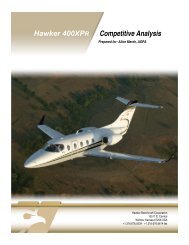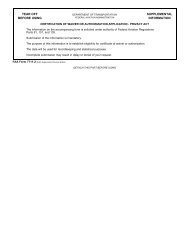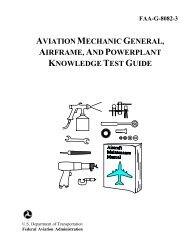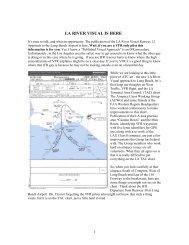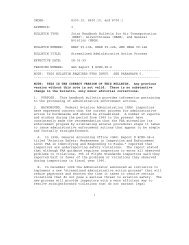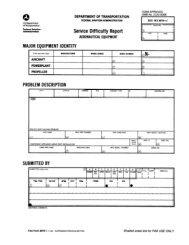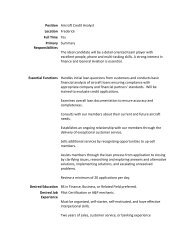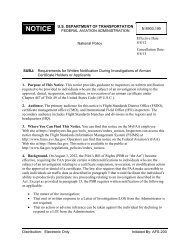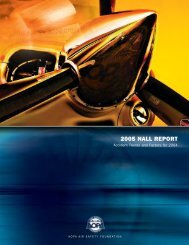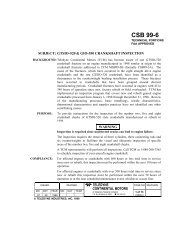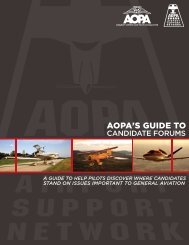2008 Nall Report - Aircraft Owners and Pilots Association
2008 Nall Report - Aircraft Owners and Pilots Association
2008 Nall Report - Aircraft Owners and Pilots Association
Create successful ePaper yourself
Turn your PDF publications into a flip-book with our unique Google optimized e-Paper software.
ACCIDENT FACTORS: OTHER PHASES OF FLIGHT<br />
• Stalls – Inadequate airspeed control during the<br />
go-around can lead to a stall.<br />
• Loss of Directional Control – Loss of directional<br />
control during the rapid application of power is<br />
another factor in go-around accidents.<br />
• Late Go-Around Attempts – Waiting until the<br />
aircraft is very near touchdown can lead to hard<br />
contact with the ground.<br />
• <strong>Aircraft</strong> Configuration – Improper configuration<br />
of l<strong>and</strong>ing gear <strong>and</strong> flaps can lead to poor aircraft<br />
climb performance followed by collision with<br />
ground objects.<br />
Failure to maintain airspeed resulting in a stall accounted<br />
for 42.5 percent of go-around accidents<br />
(Figure 40). Seventeen of the 40 accidents were<br />
stalls, eleven involved loss of directional control,<br />
seven were attributed to late decisions to go<br />
around, <strong>and</strong> five were caused by failures to reconfigure<br />
the aircraft correctly.<br />
Types of Go-Around Accidents<br />
All Accidents Fatal Accidents<br />
Stalls 17 (42.5%) 5 (55.6%)<br />
Loss of<br />
directional control 11 (27.5%) 3 (33.3%)<br />
Late go-around<br />
attempts 7 (17.5%) 1 (11.1%)<br />
<strong>Aircraft</strong> configuration 5 (12.5%) 0<br />
A higher proportion of go-around crashes occurred<br />
in more complex aircraft, but only two of<br />
the single-engine fixed-gear models were high-performance<br />
aircraft. Note the much higher lethality<br />
of go-around accidents in twins <strong>and</strong> retractables,<br />
likely associated with the higher energy levels of<br />
more complex aircraft – 43.8 percent vs. 8.3 percent<br />
in fixed-gear singles.<br />
Instructional flights accounted for a relatively<br />
high proportion (9 of 40, or 22.5 percent) of goaround<br />
accidents, <strong>and</strong> one-third of the fatal ones.<br />
Twenty-nine of the remaining 31, <strong>and</strong> five of the<br />
remaining six fatal accidents, occurred on personal<br />
flights.<br />
<strong>Aircraft</strong> Involved in Go-Around Accidents<br />
All Accidents Fatal Accidents<br />
Single-engine fixed 24 (60.0%) 2 (22.2%)<br />
SE retractable 13 (32.5%) 6 (66.7%)<br />
Multiengine 3 (7.5%) 1 (11.1%)<br />
Figure 41<br />
Ninety percent (36) of accidents in this phase occurred<br />
in daytime VMC, including six of nine fatal<br />
accidents. Both of those that took place in instrument<br />
conditions were fatal, as was one of the two accidents<br />
in VMC at night. Three out of four go-around accidents<br />
in restricted visibility proved fatal compared to<br />
one-sixth of those in daylight visual conditions.<br />
Figure 40<br />
Only one-fourth of pilots involved in go-around<br />
accidents held commercial or ATP certificates, but<br />
half of these were fatal, in contrast with only 13<br />
percent (4 of 30) of those among private, sport,<br />
<strong>and</strong> student pilots. Student pilots were responsible<br />
for five accidents, none of them fatal.<br />
27



